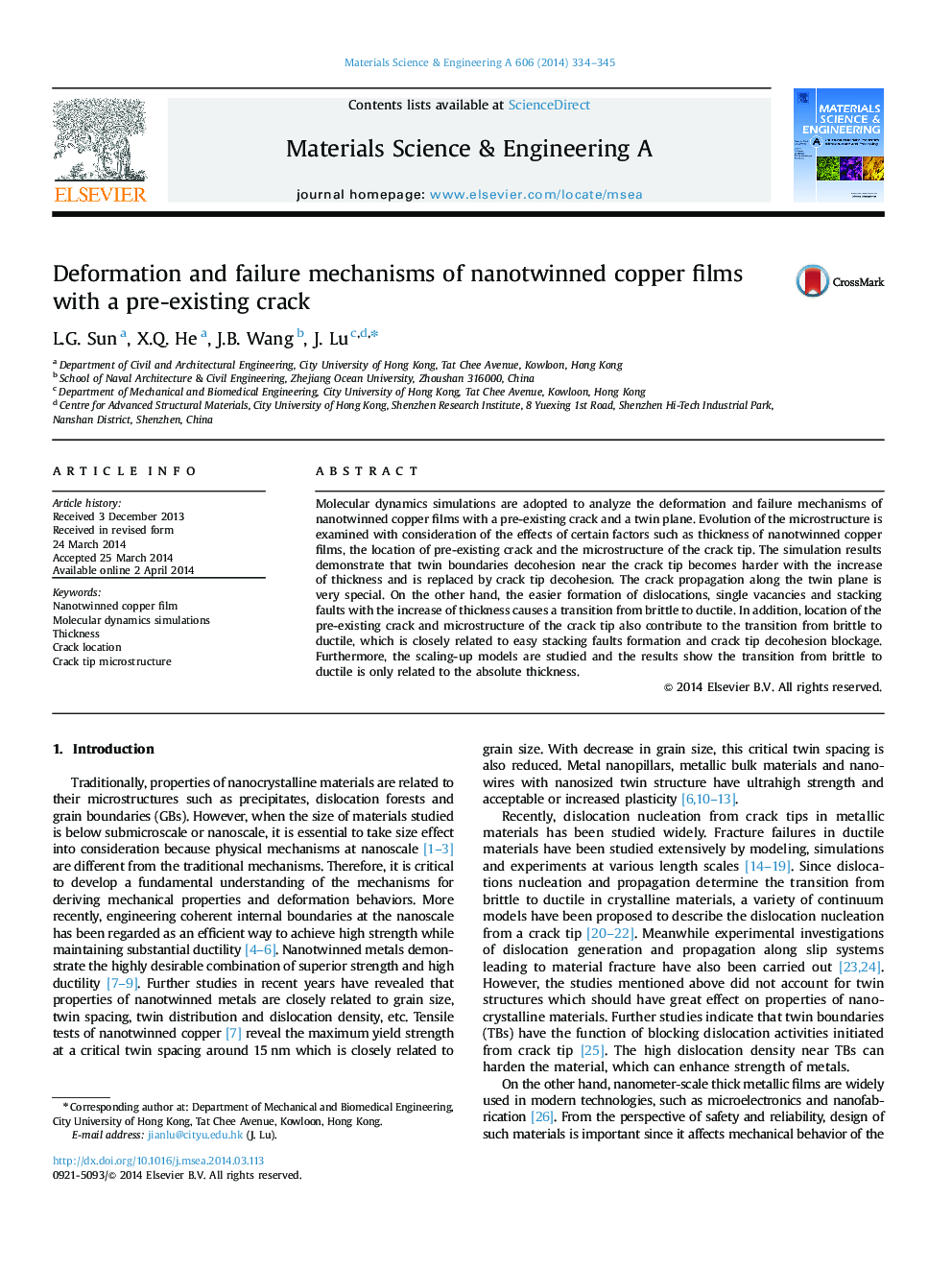| کد مقاله | کد نشریه | سال انتشار | مقاله انگلیسی | نسخه تمام متن |
|---|---|---|---|---|
| 1575063 | 1514737 | 2014 | 12 صفحه PDF | دانلود رایگان |
عنوان انگلیسی مقاله ISI
Deformation and failure mechanisms of nanotwinned copper films with a pre-existing crack
ترجمه فارسی عنوان
تغییر شکل و شکست مکانیسم های نانولوله های مس با یک کرک از پیش موجود
دانلود مقاله + سفارش ترجمه
دانلود مقاله ISI انگلیسی
رایگان برای ایرانیان
کلمات کلیدی
فیلم مسی نانوتوینید، شبیه سازی دینامیک مولکولی، ضخامت موقعیت مکانی، میکروساختار نوک کراک،
ترجمه چکیده
شبیه سازی دینامیکی مولکولی برای تجزیه و تحلیل مکانیزم ناپایداری و شکست مکانیکی فیلم های نانولوله های مس با کراک قبلا موجود و یک صفحه دوقلو به کار رفته است. تکامل ریزساختار با در نظر گرفتن اثرات عوامل خاصی از قبیل ضخامت نانولوله های مس، محل کرک قبلی و ریز ساختار نوک کرک مورد بررسی قرار گرفته است. نتایج شبیه سازی نشان می دهد که مرزهای دوقلو در حال نزدیک شدن به نوک ترخون با افزایش ضخامت، سخت تر می شود و با نوسان تکه تکه شدن جایگزین می شود. انتشار کرم در طول دوقلو بسیار ویژه است. از سوی دیگر، تشکیل ساده تر جابجایی، واحدهای خالی و گسل های انباشته با افزایش ضخامت باعث انتقال از شکننده به ورقه می شود. علاوه بر این، محل کرک قبلی و ریز ساختار نوک کرک نیز به انتقال از شکننده به ورقه ورقه کمک می کند، که به طور نزدیک به تشکیل گسل آسان و مرتب شدن و انسداد سازگاری نوک تیز است. علاوه بر این، مدل های مقیاس پذیری مورد مطالعه قرار گرفته و نتایج نشان می دهد که انتقال از شکننده به ورقه فقط مربوط به ضخامت مطلق است.
موضوعات مرتبط
مهندسی و علوم پایه
مهندسی مواد
دانش مواد (عمومی)
چکیده انگلیسی
Molecular dynamics simulations are adopted to analyze the deformation and failure mechanisms of nanotwinned copper films with a pre-existing crack and a twin plane. Evolution of the microstructure is examined with consideration of the effects of certain factors such as thickness of nanotwinned copper films, the location of pre-existing crack and the microstructure of the crack tip. The simulation results demonstrate that twin boundaries decohesion near the crack tip becomes harder with the increase of thickness and is replaced by crack tip decohesion. The crack propagation along the twin plane is very special. On the other hand, the easier formation of dislocations, single vacancies and stacking faults with the increase of thickness causes a transition from brittle to ductile. In addition, location of the pre-existing crack and microstructure of the crack tip also contribute to the transition from brittle to ductile, which is closely related to easy stacking faults formation and crack tip decohesion blockage. Furthermore, the scaling-up models are studied and the results show the transition from brittle to ductile is only related to the absolute thickness.
ناشر
Database: Elsevier - ScienceDirect (ساینس دایرکت)
Journal: Materials Science and Engineering: A - Volume 606, 12 June 2014, Pages 334-345
Journal: Materials Science and Engineering: A - Volume 606, 12 June 2014, Pages 334-345
نویسندگان
L.G. Sun, X.Q. He, J.B. Wang, J. Lu,
